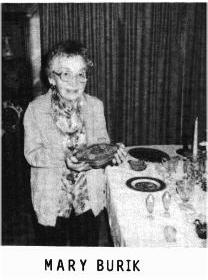Worker of the Month - Mary Burik
by Loraine
Weinman
Issue No. 206
June 1990
As a recent guest of the Cambridge Cordial Study Group, Mary Burik agreed to a videotaped interview. This former Cambridge Glass Company worker has added her knowledge and personal memories to this ongoing project.
 Mary described her experiences in the Hot Wax and Etching
departments. She was employed at the Cambridge Glass Company two
separate times. The first was for only a short time; but, the second
was from 1935 until the company closed. Since she lived in Byesville,
she took a bus to get to work . . . but found that around Christmas
when there were so many shoppers and the weather was nice, it was
quicker to walk home along the railroad tracks. Anyone familiar with
the area realizes that this is not just a "walk around the block."
Mary described her experiences in the Hot Wax and Etching
departments. She was employed at the Cambridge Glass Company two
separate times. The first was for only a short time; but, the second
was from 1935 until the company closed. Since she lived in Byesville,
she took a bus to get to work . . . but found that around Christmas
when there were so many shoppers and the weather was nice, it was
quicker to walk home along the railroad tracks. Anyone familiar with
the area realizes that this is not just a "walk around the block."
In the Hot Wax department, the pay was by "day rate," not "piece work." Her wages were eighteen cents an hour for six and a half days of work (nine dollars a week). When asked if there were any pieces of glass that could be purchased for eighteen cents, she replied that you could sign up for goblets that were seconds, selling for seventeen cents apiece. Mary stated, that originally they had no vacation or insurance benefits. Later on they did get some insurance.
Mary gave an account of what she did while employed in the Graduating department. She described how one person would use water to measure amounts and would put dots on the containers; then, Mary's job was to etch a circle around the dots.
She continued with a vivid description of the Wax department. Each girl had her own table with her own tools. The tables were made of tin and had heated tubs of wax on them. The workers used different sized artist brushes which they dipped in the hot wax and then applied to the places where the glass was to remain bare. She showed how she put the wax on the top edge and inside of the glass. The stems were dipped last. While the wax on the stems was still warm, they were stuck to a board that had the worker's number on it. This way the company could keep track of production. Each worker inspected her own work. Those pieces with errors could be washed off and started over. After the wax was applied, the glass was taken to be dipped in the acid.
Mary's favorites were the sherbets because she found them to be the easiest to handle. She said that plates and bowls were a lot slower. Some days they did stemware all the day and other days they had a variety of items. While she was working there, she only worked on crystal items.
These memories and descriptions have helped us picture these processes. The personal stories were extremely interesting. We appreciate Mary Burik's cooperation in this interview and videotaping. The next "Worker of the Month" will be Susanna Stillion, who offered some additional views of working at the Cambridge Glass Company.
